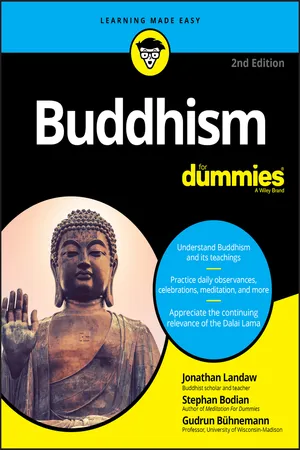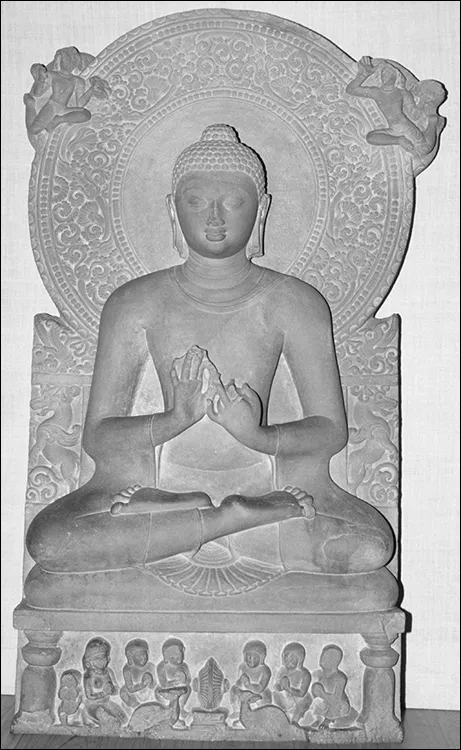![]()
Part 1
Embarking on a Journey: The Basics of Buddhism
IN THIS PART …
Want to find out what Buddhism actually means, and whether it’s a religion, a philosophy, a psychology, or something else? Well, look no further than the pages contained in this part. We also introduce you to the Buddhist understanding of the mind and its importance, and we tell you about the treasures inside you that Buddhism wants to help you discover. That seems well worth the price of admission, doesn’t it?
![]()
Chapter 1
Entering the World of Buddhism: The Basics
IN THIS CHAPTER
Realizing Buddhism’s growing popularity Considering whether Buddhism is a religion Examining the role of the Buddha Understanding the significance of Buddhist philosophy Exploring Buddhist practices Not too long ago, the West was virtually unfamiliar with the teachings of Buddhism. Back in the 1950s and ’60s, for example, you could’ve gone about your life scarcely hearing the word Buddhism mentioned. Sure, you may have come across Buddhist concepts in school in the writings of American Transcendentalists like Thoreau and Emerson (who read English translations of Buddhist texts in the mid–19th century). But the fact is, if you were like most middle-class people then, you may have grown up, grown old, and died without ever meeting a practicing Buddhist — except perhaps in an Asian restaurant.
If you wanted to find out about Buddhism in those days, your resource options were few and far between. Aside from a rare course in Eastern philosophy at a large university, you’d have had to dig deep into the shelves and stacks at your local library to discover anything more than the most basic facts about Buddhism. The few books that you could get your hands on tended to treat Buddhism as if it were an exotic relic from some long-ago and faraway land, like some dusty Buddha statue in a dark corner of the Asian section of a museum. And good luck if you wanted to find a Buddhist center where you could study and practice.
Today the situation is much different. Buddhist terms seem to pop up everywhere. You can find them in ordinary conversation (“It’s just your karma”), on television (Dharma and Greg), and even in the names of rock groups (Nirvana). Famous Hollywood stars, avant-garde composers, pop singers, and even one highly successful professional basketball coach practice some form of Buddhism. (We’re thinking of Richard Gere, Philip Glass, Tina Turner, and Phil Jackson, but you may be able to come up with a different list of celebrities on your own.)
Bookstores and libraries everywhere boast a wide range of Buddhist titles, some of which — like the Dalai Lama’s Art of Happiness (Riverhead Books) — regularly top The New York Times best-seller lists. And centers where people can study and practice Buddhism are now located in most metropolitan areas (and many smaller cities as well).
What caused such a dramatic change in just a few decades? Certainly, Buddhism has become more available as Asian Buddhist teachers and their disciples have carried the tradition to North America and Europe. (For more on the influx of Buddhism to the West, see Chapter 5.) But there’s more to the story than increased availability. In this chapter, we try to account for the appeal this ancient tradition has in today’s largely secular world by looking at some of the features responsible for its growing popularity.
Figuring Out Whether Buddhism Is a Religion
Wondering whether Buddhism is actually a religion may seem odd. After all, if you consult any list of the world’s major religious traditions, you inevitably find Buddhism mentioned prominently alongside Christianity, Islam, Hinduism, Judaism, and the rest. No one ever questions whether these other traditions are religions. But this question comes up repeatedly in relation to Buddhism.
The answer depends on how you define religion. Ask most people what comes to mind when they think of religion, and they’ll probably mention something about the belief in God, especially when discussing the creator of the world or universe. Our dictionary agrees. Webster’s New World College Dictionary defines religion as a “belief in a divine or superhuman power or powers to be obeyed and worshiped as the creator(s) and ruler(s) of the universe.”
If this definition were the only definition of religion, you’d definitely have to count Buddhism out! Why? Well, we have two reasons:
- Worship of a supernatural power isn’t the central concern of Buddhism. God (as this word is ordinarily used in the West) is absent from Buddhist teachings, although some Buddhists do worship gods and celestial Buddhas.
- Buddhism isn’t primarily a system of belief. Although it teaches certain doctrines (as we discuss throughout Part 3), many Buddhist teachers actively encourage their students to adopt an attitude that’s the opposite of blind faith.
Many Buddhist teachers advise you to be skeptical about teachings you receive. Don’t passively accept what you hear or read — and don’t automatically reject it, either. Instead, use your intelligence. See for yourself whether the teachings make sense in terms of your own experience and the experience of others. Then, as the Dalai Lama of Tibet (see Chapter 15) often advises, “If you find that the teachings suit you, apply them to your life as much as you can. If they don’t suit you, just leave them be.”
This more practical approach agrees with both the spirit and the letter of the Buddha’s own teachings. The Buddha is believed to have declared, “Do not accept anything I say as true simply because I have said it. Instead, test it as you would gold to see if it is genuine or not. If, after examining my teachings, you find that they are true, put them into practice. But do not do so simply out of respect for me.”
Buddhist teachings therefore encourage you to use the entire range of your mental, emotional, and spiritual abilities and intelligence — instead of merely placing your blind faith in what past authorities have said. This attitude makes the teachings of Buddhism especially attractive to many Westerners; although it’s 2,500 years old, it appeals to the postmodern spirit of skepticism and scientific investigation.
If Buddhism is
not primarily a belief system and isn’t centered upon the worship of a supreme deity, then why is it classified as a religion at all? Like all religions, Buddhism gives people who practice it a way of finding answers to the deeper questions of life, such as “Who am I?” and “Why am I here?” and “What is the meaning of life?” and “Why do we suffer?” and “How can I achieve lasting happiness?”
In addition to fundamental teachings on the nature of reality, Buddhism offers a method, a systematic approach involving techniques and practices, that enables its followers to experience a deeper level of reality directly for themselves. In Buddhist terms, this experience involves waking up to the truth of your authentic being, your innermost nature. The experience of awakening is the ultimate goal of all Buddhist teachings. (For more on awakening — or enlightenment, as it’s often called — see Chapter 10.) Some schools emphasize awakening more than others (and a few even relegate it to the background in their scheme of priorities), but in every tradition, it’s the final goal of human existence — whether achieved in this life or in lives to come.
By the way, you don’t have to join a Buddhist organization to benefit from the teachings and practices of Buddhism. For more info on the different stages of involvement in Buddhism, see Chapter 6.
Recognizing the Role of the Buddha
Buddhist systems are based upon the teachings given 2,500 years ago by one of the great spiritual figures of human history, Shakyamuni Buddha, who lived in the fifth century BCE. According to legendary accounts of his life (see Chapter 3), he was born into the ruling family of the Shakya clan in today’s Nepal and was expected to someday succeed his father as king. Instead, Prince Siddhartha (as he was known at the time) quit the royal life at the age of 29 after he saw the reality of the extensive suffering and dissatisfaction in the world. He then set out to find a way to overcome this suffering.
After many hardships, at age 35, Prince Siddhartha achieved his goal. Seated under what became known as the Bodhi tree — the tree of enlightenment — he achieved the awakening of Buddhahood. Today a stone platform known as the diamond seat (vajrasana) near the Bodhi tree in Bodh Gaya (see Figure 1-1) marks the spot. From then on, he was known as Shakyamuni Buddha, the awakened (Buddha) sage (muni) of the Shakya clan.
Prince Siddhartha spent the remaining 45 years of his life wandering the northern part of the Indian subcontinent, teaching anyone who was interested in the path that leads to freedom from suffering. The famous Buddha statue in Sarnath (India), the place where he gave his first sermon (see Figure 1-2), shows the Buddha making the gesture of turning the wheel of his teaching. (Part 3 offers an overview of the entire Buddhist path.) After a lifetime of compassionate service to others, Shakyamuni died at the age of 80.
The question is often asked, “What kind of being was Shakyamuni Buddha — a ma...









